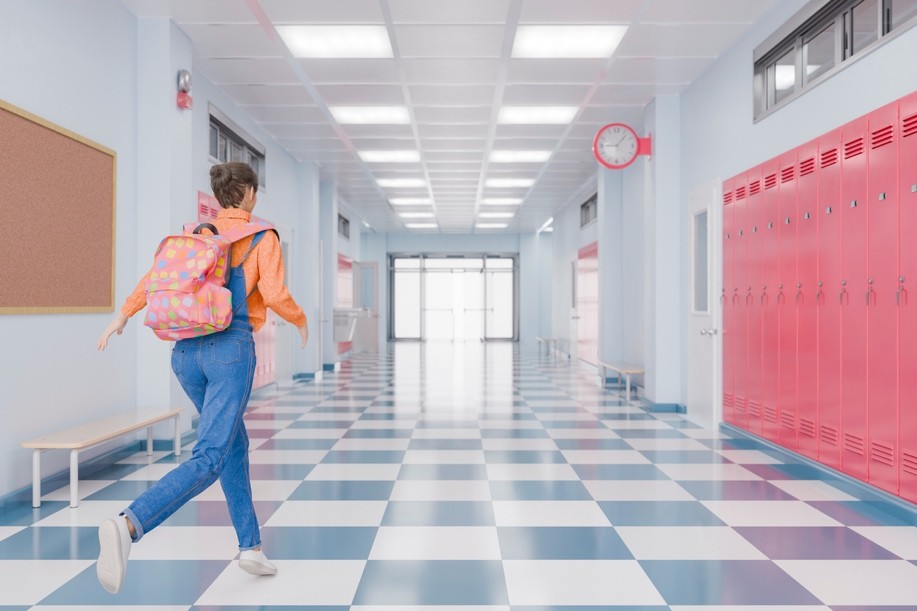Biophilic design is an innovative architectural concept that seeks to integrate natural elements and patterns into living and learning environments. One great example of the power of biophilic design is a school for neurodiverse students in the UK. The Garden School, a school for autistic children, turned a former storage space into a recuperation space for children who were feeling overwhelmed with noise and activity on the playground. Because incorporating natural plants was not feasible for this group of children, the designers used natural textures, soothing colors, and wallpaper with soothing images of forests to help reduce stress.
Biophilic design is rooted in the biophilia hypothesis that humans have a natural connection and innate love for nature. By bringing nature into our indoor spaces, biophilic design aims to satisfy this fundamental human need for connection with the natural world, even within urban and artificial settings.
The importance of incorporating biophilic design into educational environments cannot be exaggerated at a time when student stress and anxiety is at an all-time high. Students spend a significant portion of their day in classrooms and on school grounds, so these spaces play a crucial role in shaping their perceptions, values, and relationship with the natural world. By incorporating elements such as natural light, indoor plants, organic materials, and views of nature into educational spaces, designers and school leaders can create environments that support the health and well-being of students, teachers, and the entire school community

The Science Behind Biophilic Design
Research has consistently shown that exposure to nature and natural elements can reduce stress, improve cognitive function, and enhance overall well-being. A ground breaking study found that hospital patients with views of nature recovered faster than those without.1
In educational contexts, several studies have demonstrated the positive impacts of biophilic design:
1. Improved Attention: Research has found that children with ADHD showed improved concentration after spending time in green outdoor spaces.2
2. Reduced Stress: Research also found that high school students with views of green landscapes from their classroom windows recovered from stressful events more quickly than those without such views.3
3. Enhanced Creativity: Research indicates that immersion in nature improves creative problem-solving skills by up to 50%.4
Early Childhood and Elementary Education
For young children, the integration of biophilic design in classrooms and playgrounds can have profound effects on their development. Natural elements such as indoor plants, water features, and nature-inspired textures can stimulate sensory exploration and creativity. Additionally, large windows that provide ample natural light and views of the outdoors can help children maintain a connection with the rhythms of nature, even when inside.
Incorporating elements such as living plants, natural materials like wood and stone, and nature-inspired patterns and textures can create a calming and engaging environment that supports their cognitive and social development.
One innovative approach is the creation of indoor nature-play areas, where children can interact with natural elements like sand, water, and vegetation. Outdoor learning spaces that incorporate native plant species, vegetable gardens, and natural play structures can provide hands-on experiences that foster curiosity about the natural world.
For example, East Elementary School in Hingham, Massachusetts, created a wonderful live plant wall panel for their students. Put together by a teacher and a para educator, the new wall is a big hit with students. Adding a living wall of plants can include just a panel, like East Elementary, or a much larger area. These areas can allow children to observe growth patterns and care for living organisms. Outdoor areas for preschoolers can include mud kitchens, butterfly gardens, and nature trails, encouraging exploratory play and early scientific observation skills. These experiences lay the foundation for environmental stewardship and a lifelong connection to nature.
Middle and High School
As students progress through middle and high school, biophilic design can support more advanced learning objectives while continuing to nurture their relationship with nature. Incorporating elements like living green walls, indoor gardens, or even small aquariums can not only enhance the aesthetic appeal of the learning spaces but also provide opportunities for hands-on learning about ecosystems, plant care, and environmental stewardship.
Nature-inspired art installations, murals, and biomorphic patterns can be integrated into the design, creating visually stimulating environments that evoke a sense of calm and focus. Green walls can serve as living laboratories for biology classes, while outdoor amphitheaters surrounded by native landscaping can provide inspiring spaces for literature and arts education.
Incorporating natural light, views of green spaces, and the use of natural materials like wood and stone can create a more calming and focused learning environment. This is particularly important during adolescence, a time often marked by stress and emotional turbulence. Biophilic design elements can help reduce stress, improve concentration, and boost overall well-being. Additionally, outdoor learning areas, such as gardens or nature traits, can serve as dynamic classrooms where students can engage in experiential learning and develop a deeper appreciation for the natural world.
College and University Campuses
At the college level, biophilic design can be integrated on a larger scale, influencing entire campus layouts and building designs. University of Denver recently installed an extensive green roof for their Community Commons building as part of their plan to become carbon neutral by 2030.
Integrating indoor green spaces, such as atria or courtyards, can provide students with access to natural light and greenery, which has been shown to improve mood, reduce fatigue, and enhance cognitive performance.
Green roofs, rain gardens, and bioswales (green gutters that replace concrete ones) can serve as living examples of sustainable water management practices. Indoor atriums with diverse plant species can create multi-functional spaces for study, relaxation, and social interaction. Biophilic design principles can also be incorporated into specific academic disciplines. Architecture students might study in buildings that exemplify sustainable design practices, while environmental science departments could utilize campus green spaces as outdoor classrooms and research sites. Additionally, incorporating natural ventilation and views of the outdoors can help create a sense of connection with the surrounding environment, fostering a sense of belonging and well-being.

10 Benefits of Biophilic Design in Education
The integration of biophilic design in educational settings offers numerous benefits that extend beyond environmental awareness:
1. Improved Cognitive Function: Studies have shown that exposure to nature and natural elements can enhance attention, memory, and problem-solving skills.
2. Reduced Stress and Anxiety: Natural environments have been linked to lower stress levels and improved emotional well-being among students and staff.
3. Enhanced Creativity: Biophilic spaces can stimulate creativity and inspire innovative thinking across various disciplines.
4. Improved Physical Health: Access to nature and natural light can boost vitamin D levels, improve sleep patterns, and encourage physical activity.
5. Increased Environmental Awareness: Regular interaction with natural elements fosters a deeper understanding and appreciation of ecological systems and environmental issues.
6. Better Air Quality: Indoor plants and living walls can improve air quality by filtering pollutants and increasing oxygen levels.
7. Energy Efficiency: Biophilic design often incorporates sustainable building practices, leading to more energy-efficient educational facilities.
8. Sensory Regulation: Natural elements can provide gentle, predictable sensory input that helps regulate the nervous system. For example, the sound of flowing water or the subtle movement of leaves can be calming without being overwhelming.
9. Visual Comfort: Natural lighting and views of nature can reduce visual stress often associated with fluorescent lighting and stark interiors. This can be especially helpful for individuals with autism or sensory processing disorders.
10. Improved Focus: Patterns found in nature (known as fractals) have been shown to capture attention in a way that is both engaging and restful. This can support better focus and reduced mental fatigue.
Sources
- Kuo, F. E., & Taylor, A. F. (2004). A potential natural treatment for attention-deficit/hyperactivity disorder: evidence from a national study. American journal of public health, 94(9), 1580–1586.
- Li, D., & Sullivan, W. C. (2016). Impact of views to school landscapes on recovery from stress and mental fatigue. Landscape and Urban Planning, 148, 149–158.
- Atchley, R. A., Strayer, D. L., & Atchley, P. (2012). Creativity in the wild: improving creative reasoning through immersion in natural settings. PloS one, 7(12).









